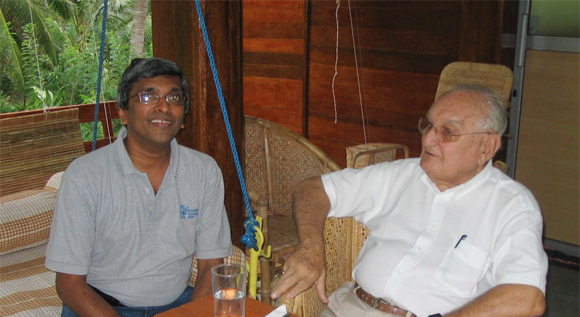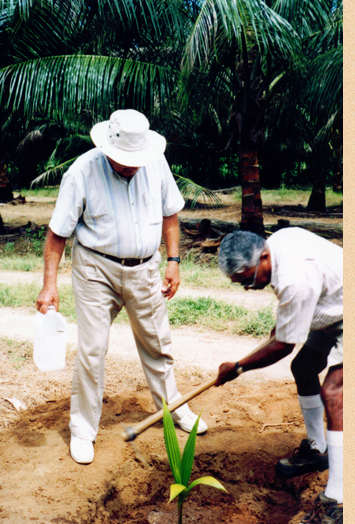Ray Wijewardene: the Coconut Farmer

Dr Ranjith Mahindapala recalls his many years going coconuts with Ray.
Ray Wijewardene’s contributions to agricultural development in Sri Lanka will be remembered for a long time. A legend of the modern times, he used his training in engineering to focus on agricultural development very effectively.
He was an outstandingly innovative scientist, always with an inquiring mind. He loved things mechanical, and would tinker with anything new which came his way. He was far ahead of his contemporaries, and would never give up experimenting with new ideas, however esoteric they might seem to be.
When I was Director of the Coconut Research Institute, I was closely associated with Ray who served both as a Member of the Coconut Research Board and on its Research Committee for nearly a decade. His incisive mind contributed greatly in focussing on new areas of work. He would challenge the researchers into new thinking, but always understood the difficulties faced by them.
In the early 1980s, together with Dr U P de S Waidyanatha, Ray co-authored a well illustrated book titled Conservation Farming (for Small Farmers in the Humid Tropics). This was written at a time when the term conservation was hardly heard. He advocated conserving soil moisture, particularly in the dryer areas of the country by avoiding such practices as tilling and clean weeding.
He would often remark how rice farmers flood their paddies merely to control weeds -- an extravagantly wasteful use of precious water, far in excess of what the rice plant itself needs. He showed how better rice yields could be obtained using much less water.
 When Ray started talking about these issues in the 1980s, agricultural practices based on saving soil water were not widely practiced in the country, perhaps because soil water deficits were still uncommon. Yet he foresaw what shortages of the near future, and on every possible occasion, extolled to virtues of conserving soil moisture. He challenged fellow scientists to think about these aspects. Conservation Farming is even more relevant in today’s context; it was translated into Sinhala by IUCN, International Union for Conservation of Nature in 2009.
When Ray started talking about these issues in the 1980s, agricultural practices based on saving soil water were not widely practiced in the country, perhaps because soil water deficits were still uncommon. Yet he foresaw what shortages of the near future, and on every possible occasion, extolled to virtues of conserving soil moisture. He challenged fellow scientists to think about these aspects. Conservation Farming is even more relevant in today’s context; it was translated into Sinhala by IUCN, International Union for Conservation of Nature in 2009.
Ray was a strong promoter of cover cropping for improving soil conditions, and tried to revive the old practice of ‘green manuring’. Gradually, this led to his work on Gliricidia. In the hill country, he advocated using the Sloping Agricultural Land Technology (SALT) to reduce erosion and to enrich the soil. Within a few years, SALT could turn barren sloping lands into productive upland farms.
He also promoted Gliricidia planting in coconut lands, and persuaded the Coconut Research Institute to undertake further research on it. Later, he ventured into using Gliricidia wood as the raw material for dendro power as an alternative method of generating electricity.
The idea was field tested with a small biomass gasifier that he installed in his own coconut estate, Kohombe, which was a veritable research field with all kinds of experiments. In fact, he believed in trying out new ideas on his own, and invested a good deal of his personal funds for this research. He was truly an applied researcher who showed how to combine traditional and modern knowledge to obtain the highest coconut yields in the whole country – which was three times the national average.
It was an exhilarating experience to engage in discussions with him, on any subject, be it agriculture, engineering or energy, in his little stilt house at the estate. Although he had a Harvard Business School qualification, he felt that economics of agricultural practices should take into account long-term effects on land and water. He would argue that poor returns today would not necessarily mean poor returns in another 10 years.
 |
Dr Ranjith Mahindapala served as Director of Sri Lanka’s Coconut Research Institute before joining IUCN, the International Union for Conservation of Nature, where he is now Programme Manager of Mangroves for the Future, an Asian regional programme. |

